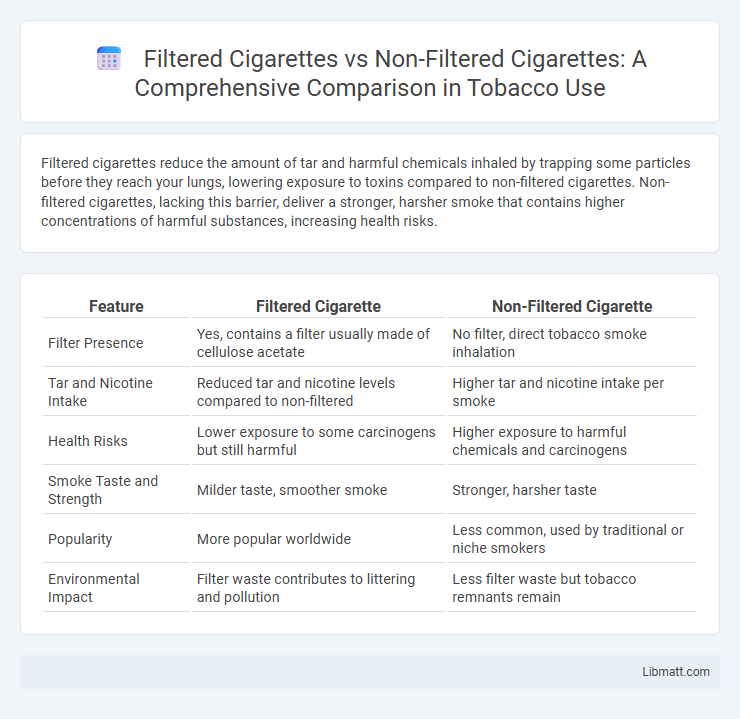Filtered cigarettes reduce the amount of tar and harmful chemicals inhaled by trapping some particles before they reach your lungs, lowering exposure to toxins compared to non-filtered cigarettes. Non-filtered cigarettes, lacking this barrier, deliver a stronger, harsher smoke that contains higher concentrations of harmful substances, increasing health risks.
Table of Comparison
| Feature | Filtered Cigarette | Non-Filtered Cigarette |
|---|---|---|
| Filter Presence | Yes, contains a filter usually made of cellulose acetate | No filter, direct tobacco smoke inhalation |
| Tar and Nicotine Intake | Reduced tar and nicotine levels compared to non-filtered | Higher tar and nicotine intake per smoke |
| Health Risks | Lower exposure to some carcinogens but still harmful | Higher exposure to harmful chemicals and carcinogens |
| Smoke Taste and Strength | Milder taste, smoother smoke | Stronger, harsher taste |
| Popularity | More popular worldwide | Less common, used by traditional or niche smokers |
| Environmental Impact | Filter waste contributes to littering and pollution | Less filter waste but tobacco remnants remain |
Introduction to Filtered vs Non-Filtered Cigarettes
Filtered cigarettes contain a cellulose acetate filter designed to reduce tar, nicotine, and other harmful substances inhaled during smoking, while non-filtered cigarettes lack this barrier, resulting in a harsher and more concentrated smoke. Studies show filtered cigarettes tend to deliver lower levels of toxic compounds, but both types pose significant health risks due to the presence of carcinogens and addictive chemicals. Your choice between filtered and non-filtered cigarettes can impact the degree of exposure to harmful substances, though quitting remains the best way to protect your health.
Historical Development of Cigarette Filters
The historical development of cigarette filters began in the early 20th century as a response to increasing health concerns related to smoking. Filtered cigarettes gained popularity in the 1950s with the introduction of cellulose acetate filters designed to reduce tar and nicotine intake. Advances in filter technology continue to evolve, integrating activated charcoal and multi-layer filtration to enhance smoke purification.
Composition and Construction Differences
Filtered cigarettes contain a cellulose acetate filter that traps some tar, nicotine, and other harmful substances, reducing the amount inhaled by the smoker. Non-filtered cigarettes lack this filtration layer, consisting solely of tobacco wrapped in paper, resulting in higher exposure to tar and particulates. The construction of filtered cigarettes includes multiple components--filter, tobacco rod, and paper--while non-filtered cigarettes are simpler, often leading to increased health risks due to unfiltered smoke inhalation.
Smoking Experience: Taste and Smoothness
Filtered cigarettes offer a smoother smoking experience by reducing the harshness of tobacco smoke through activated charcoal or fibrous filters, which trap tar and harmful particles. Non-filtered cigarettes deliver a stronger, more robust taste due to direct smoke inhalation, often perceived as richer but harsher and more irritating to the throat. Smokers seeking a milder flavor and reduced throat irritation typically prefer filtered cigarettes, while those who favor intense tobacco flavors tend to choose non-filtered options.
Health Risks and Toxicity Comparison
Filtered cigarettes reduce the intake of tar, nicotine, and other harmful chemicals by trapping some particles before inhalation, lowering exposure to carcinogens compared to non-filtered cigarettes. Non-filtered cigarettes deliver higher levels of toxic substances directly to the lungs, increasing the risk of respiratory diseases, lung cancer, and cardiovascular problems. Studies consistently show that smokers of non-filtered cigarettes face significantly greater health risks due to the increased toxicity and unmitigated exposure to harmful compounds.
Impact on Smoking Habits and Behavior
Filtered cigarettes reduce the harshness and amount of tar inhaled, often leading smokers to take deeper or more frequent puffs to maintain nicotine intake, which can alter smoking behavior. Non-filtered cigarettes deliver higher levels of tar and nicotine per puff, typically resulting in shorter smoking duration but increased exposure to harmful substances. Differences in cigarette filtration influence user experience, dependence levels, and inhalation patterns, affecting overall smoking habits.
Marketing Strategies and Consumer Perception
Filtered cigarettes are heavily marketed using health-related claims, emphasizing reduced tar and harmful substance intake compared to non-filtered varieties, which shapes consumer perception toward viewing them as a safer choice. Packaging design, brand positioning, and targeted advertising campaigns reinforce the image of filtered cigarettes as modern and less harmful, influencing Your purchasing decisions. Non-filtered cigarettes often appeal to traditional or niche markets but lack widespread promotional efforts, resulting in lower mainstream consumer acceptance.
Regulatory Considerations and Bans
Filtered cigarettes are subject to stricter regulatory considerations due to their perceived reduced harm, leading many countries to implement specific labeling and marketing restrictions. Non-filtered cigarettes face bans or severe limitations in several regions because of higher tar and toxin delivery, driving public health policies to discourage their use. Your understanding of these regulations is crucial when navigating tobacco product availability and compliance across different markets.
Environmental Effects of Cigarette Filters
Cigarette filters, primarily made from non-biodegradable cellulose acetate, significantly contribute to environmental pollution due to their persistence in ecosystems and difficulty in natural decomposition. Non-filtered cigarettes, lacking this synthetic component, produce less solid waste but still release harmful chemicals into the environment through smoke residue and discarded tobacco remains. Your choice between filtered and non-filtered cigarettes impacts the volume and toxicity of litter, affecting soil and water quality.
Future Trends in Cigarette Design
Future trends in cigarette design emphasize reduced health risks, with filtered cigarettes evolving to include advanced filtration materials like activated charcoal and biodegradable filters to minimize harmful smoke exposure. Non-filtered cigarettes may decline due to growing awareness of their higher toxicant delivery, prompting manufacturers to focus on improving filter efficiency and ecological sustainability in Your smoking options. Innovations will prioritize balancing flavor retention with enhanced toxin reduction to align with tightening regulatory standards and consumer health demands.
Filtered cigarette vs non-filtered Infographic

 libmatt.com
libmatt.com